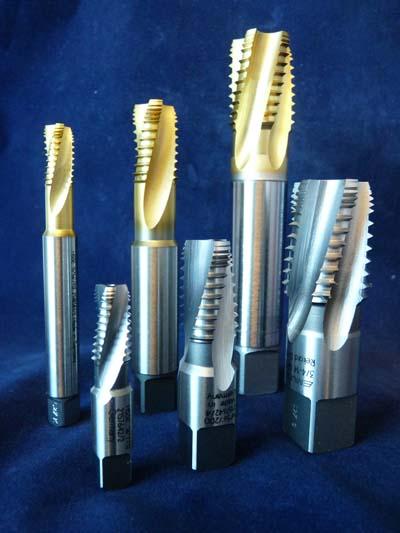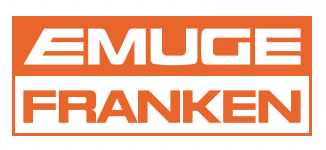
Emuge Corp. has introduced a line of NPT Taper Pipe Taps that features a newly developed flute form with variable skip tooth geometry. The advanced flute design optimizes chip flow and clearance and lowers tapping torque, which is ideal for materials that produce long, stringy chip formations.
Taper pipe threads have a much higher volume of chip removal in the tapping process compared to straight UN screw threads, especially in materials that are prone to clogging flutes with long chip strings, such as aluminum, carbon steels, stainless steels and mold steels. Emuge NPT taps significantly improve chip flow, provide better thread finish and gaging, in addition to higher production rates due to less machine downtime.
"The new flute design on the Emuge NPT taps allows for improved chip flow and chip clearance, which results in longer tap life than conventional pipe taps that often pre-maturely fail due to severe chipping of the cutting teeth or total breakage due to chip clogging," stated Mark Hatch, Product Director, Threads and Taps at Emuge Corp.
The new taps are precision ground to produce internal NPT pipe threads to a close tolerance on thread dimensions and limits of size, and with excellent surface quality on the thread flanks to consistently achieve tight, leak-free joints at assembly. Constructed of premium high speed steel and PVD coated for longer tool life and improved thread finish, the new taps will be stocked in pipe sizes 1⁄16 NPT thru 1" NPT, and in two overall lengths.
Taps will be offered in standard ANSI length, and the longer DIN length which allows for additional reach, chip clearance, and delivery of coolant — ideal for use on CNC machines with rigid (synchronous) tapping capabilities.
The taps are offered in bright finish for wrought aluminum materials and TiN coated for steel materials. TiCN coating is also available upon request.
Contact Details
Related Glossary Terms
- carbon steels
carbon steels
Known as unalloyed steels and plain carbon steels. Contains, in addition to iron and carbon, manganese, phosphorus and sulfur. Characterized as low carbon, medium carbon, high carbon and free machining.
- chip clearance
chip clearance
In milling, the groove or space provided in the cutter body that allows chips to be formed by the inserts.
- clearance
clearance
Space provided behind a tool’s land or relief to prevent rubbing and subsequent premature deterioration of the tool. See land; relief.
- computer numerical control ( CNC)
computer numerical control ( CNC)
Microprocessor-based controller dedicated to a machine tool that permits the creation or modification of parts. Programmed numerical control activates the machine’s servos and spindle drives and controls the various machining operations. See DNC, direct numerical control; NC, numerical control.
- coolant
coolant
Fluid that reduces temperature buildup at the tool/workpiece interface during machining. Normally takes the form of a liquid such as soluble or chemical mixtures (semisynthetic, synthetic) but can be pressurized air or other gas. Because of water’s ability to absorb great quantities of heat, it is widely used as a coolant and vehicle for various cutting compounds, with the water-to-compound ratio varying with the machining task. See cutting fluid; semisynthetic cutting fluid; soluble-oil cutting fluid; synthetic cutting fluid.
- flutes
flutes
Grooves and spaces in the body of a tool that permit chip removal from, and cutting-fluid application to, the point of cut.
- physical vapor deposition ( PVD)
physical vapor deposition ( PVD)
Tool-coating process performed at low temperature (500° C), compared to chemical vapor deposition (1,000° C). Employs electric field to generate necessary heat for depositing coating on a tool’s surface. See CVD, chemical vapor deposition.
- stainless steels
stainless steels
Stainless steels possess high strength, heat resistance, excellent workability and erosion resistance. Four general classes have been developed to cover a range of mechanical and physical properties for particular applications. The four classes are: the austenitic types of the chromium-nickel-manganese 200 series and the chromium-nickel 300 series; the martensitic types of the chromium, hardenable 400 series; the chromium, nonhardenable 400-series ferritic types; and the precipitation-hardening type of chromium-nickel alloys with additional elements that are hardenable by solution treating and aging.
- tap
tap
Cylindrical tool that cuts internal threads and has flutes to remove chips and carry tapping fluid to the point of cut. Normally used on a drill press or tapping machine but also may be operated manually. See tapping.
- tapping
tapping
Machining operation in which a tap, with teeth on its periphery, cuts internal threads in a predrilled hole having a smaller diameter than the tap diameter. Threads are formed by a combined rotary and axial-relative motion between tap and workpiece. See tap.
- titanium carbonitride ( TiCN)
titanium carbonitride ( TiCN)
Often used as a tool coating. See coated tools.
- titanium nitride ( TiN)
titanium nitride ( TiN)
Added to titanium-carbide tooling to permit machining of hard metals at high speeds. Also used as a tool coating. See coated tools.
- tolerance
tolerance
Minimum and maximum amount a workpiece dimension is allowed to vary from a set standard and still be acceptable.

